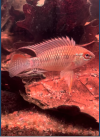Greg A
New Member
- Messages
- 7
Hi- first time posting here so hello
I recently acquired two apistogrammas, my first time keeping them. The species was not given only that one was male and the other female, I was told the female is the darker of the two. Two full days have passed now and the "female" has finally come out of hiding for me to get a good look ("she" is the lighter of the two in the photos).
From my searches I think they are ortegai, one the of varieties ("algodon II", pebas, any of the other names I've read they go by). I live in Peru and bought them from a guy who brings fish to Lima from the region so the location is known on that level. Can anyone help to positively ID them?
As far as the sex, after seeing them both out today I think they are both males. The more colorful male is definitely the dominant of the two and will pursue and bully the more drab apisto, which mostly hides under the leaf litter. Any thoughts here? Supposedly "she" was the darker of the two, perhaps she's lost her color due to moving stress and the territorial male.
He had a few others of the same species, then another yellow one with black marks that was supposedly another species. After reading, if these are ortegai, I now believe the others to all be male and the yellow one to be the female. Or is it possible he had one brooding female and also a mix of males and females that were not ready to spawn?
At any rate I think I will have to separate these two, any insight is greatly appreciated. Thanks and hello again.
I recently acquired two apistogrammas, my first time keeping them. The species was not given only that one was male and the other female, I was told the female is the darker of the two. Two full days have passed now and the "female" has finally come out of hiding for me to get a good look ("she" is the lighter of the two in the photos).
From my searches I think they are ortegai, one the of varieties ("algodon II", pebas, any of the other names I've read they go by). I live in Peru and bought them from a guy who brings fish to Lima from the region so the location is known on that level. Can anyone help to positively ID them?
As far as the sex, after seeing them both out today I think they are both males. The more colorful male is definitely the dominant of the two and will pursue and bully the more drab apisto, which mostly hides under the leaf litter. Any thoughts here? Supposedly "she" was the darker of the two, perhaps she's lost her color due to moving stress and the territorial male.
He had a few others of the same species, then another yellow one with black marks that was supposedly another species. After reading, if these are ortegai, I now believe the others to all be male and the yellow one to be the female. Or is it possible he had one brooding female and also a mix of males and females that were not ready to spawn?
At any rate I think I will have to separate these two, any insight is greatly appreciated. Thanks and hello again.




